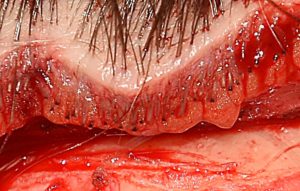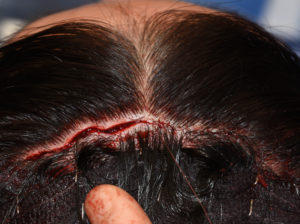Scalp incisions are a necessary part of any aesthetic skull reshaping procedure. Whether it is onlay augmentation with materials or bone reduction techniques, access to do the surgery and work under the scalp is necessary. But the resultant scalp scars in aesthetic skull surgery have much greater significance than it would for medically necessary neurosurgery or reconstructive craniofacial surgery. Because the surgery is elective, the scalp scar must be an acceptable tradeoff for the other benefits of the procedure. This is also extremely relevant as a significant of patients who undergo aesthetic skull reshaping surgery are men with either thin hair, are bald or shave their heads.

I have not found it necessary to shave or remove hair for any scalp incision. While this makes it easier to make and close the incision, it is not a source of infection even when placing implants on the skull. The superb blood supply of the scalp and skull give it naturally high resistance to infection even in the presence of hair. The hair can be parted and held down with assistance and the incision is always made irregularly, going in and out of the part line which is never perfectly straight anyway. This incisional line irregularity is one of coincidence and necessity, not a deliberate one done for better scar camouflage like in broken line scar revisions.
The scalp skin incision is made by cold steel blades, NEVER with electrocautery. Even one the incision is fully through the skin electrocautery is not used until the periosteum of the bone is reached. The heat of electrocautery damages tissues and kills hair follicles. Scissors can be used to quickly cut through the numerous scalp layers and even extend the skin incision if necessary and does so in a non-traumatic fashion. Traditional clips and clamps are not used along the skin edges as they are too traumatic. Any small bleeders can be either ignored to stop on their one and stopped by bipolar cautery. In some case to adequately retract the hair and keep it out of the surgical field, layered sponges are stapled to the cut skin edges.

Scars from scalp incisions in aesthetic skull surgery can heal extremely well and in some cases almost invisible to the naked eye. Attention to detail in making the scalp incision and its closure following these atraumatic methods have proven effective in my experience.
Dr. Barry Eppley
Indianapolis, Indiana


